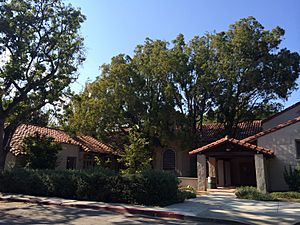Rustic Canyon, Los Angeles facts for kids
Rustic Canyon is a beautiful neighborhood and a deep valley (called a canyon) in the eastern part of Pacific Palisades. This area is on the west side of Los Angeles, California. It sits right along a small stream known as Rustic Creek, nestled within the Santa Monica Mountains.
Contents
Exploring Rustic Canyon's Geography
This neighborhood is surrounded by Sunset Boulevard to the north and Chautauqua Boulevard to the west. To the south, you'll find lower Santa Monica Canyon. Amalfi Drive and Mesa Drive are to the east. Rustic Canyon is located between the main part of Pacific Palisades and the Brentwood area of Los Angeles. It's also near the Santa Monica Canyon neighborhood of Santa Monica. The canyon's unique shape and narrow streets make it feel very private and separate.
The canyon and its creek continue north of Sunset Boulevard, with less building development. They stretch past Will Rogers State Historic Park and into the natural areas of Topanga State Park. Rustic Canyon and Santa Monica Canyon are the southernmost of many canyons that cut into the Santa Monica Mountains from Pacific Palisades all the way to Malibu.
Rustic Creek is special because it's one of the few streams in developed Los Angeles that isn't covered by concrete. It flows freely until it joins Santa Monica Creek, which then empties into the nearby Santa Monica Bay. The area is very green and full of plants. You can see coast live oak trees, California sycamores, different types of Eucalyptus trees, and many other pretty ornamental trees.
Rustic Canyon's Unique Weather
The narrow canyon has its own special weather, called a microclimate. It's cooler and a bit more humid than most other parts of Los Angeles. Coastal fog is common throughout the year. In winter, temperatures rarely drop below 35 degrees Fahrenheit (about 1.7 degrees Celsius). In summer, temperatures rarely go above 80 degrees Fahrenheit (about 26.7 degrees Celsius). Because it's humid and surrounded by many homes, the canyon is safer from wildfires than other places near the Santa Monica Mountains.
Homes in the canyon use the 90272 ZIP Code for Pacific Palisades or the 90402 for Santa Monica. However, all these homes are part of the City of Los Angeles.
A Look Back at Rustic Canyon's History
The first people to live in this area were the Tongva people. After 1771, Spanish missionaries called them "Gabrieleño." This was because they were in the area looked after by Mission San Gabriel. The first Europeans to visit were part of the Portola expedition in 1769. They tried to follow the coast but were stopped by cliffs. The next day, they went inland and found a way north through Sepulveda Canyon.
Mexican Rule and Early Uses
When Mexico ruled the land, the area between Topanga Canyon and today's Santa Monica was part of the Rancho Boca de Santa Monica. Important families like the Marquez, Reyes, and Sepúlveda families used this land for grazing animals and collecting firewood. In the late 1800s, the canyon became known as a great place for camping. It was a quiet getaway close to the beach hotels and resorts in nearby Santa Monica.
Abbot Kinney, who created the nearby community of Venice Beach, started an experimental tree station here. He planted many eucalyptus trees in the lower canyon, and some are still there today. In the late 1800s, people even thought about building the Port of Los Angeles at the mouth of the canyon. However, San Pedro Bay was chosen instead.
The Uplifters Club
In the early 1900s, a group called the Uplifters started a social club and ranch in Rustic Canyon. This group was connected to the important Los Angeles Athletic Club. They built many ranch-style and cabin-style houses. These were used as second homes for weekend trips and longer vacations. The Uplifters also became friends with Will Rogers, whose ranch was just across Sunset Boulevard. They even built a polo field in the canyon.
The Uplifters club was known as a private place for many important local politicians and wealthy people. The canyon's quiet location made it a perfect retreat for these powerful members. They mostly lived in fancy areas near downtown Los Angeles and in Pasadena. A sign that says "Uplifters Ranch" still hangs over Latimer Road, near where their clubhouse used to be. The clubhouse was designed by architect William J. Dodd.
After the Great Depression, the club started selling off its properties. It officially closed in 1947. The clubhouse and nearby fun areas, like a swimming pool, baseball field, and tennis courts, were given to the city in the early 1950s. Today, these are part of the Rustic Canyon Recreation Center city park.
Police Services
The Los Angeles Police Department helps keep the neighborhood safe. Their West Los Angeles Community Police Station is located at 1663 Butler Avenue, 90025.
Homes in Rustic Canyon
This neighborhood is mostly made up of single-family homes. There are no big stores or businesses directly in the canyon. The closest shops, restaurants, and a gas station are in lower Santa Monica Canyon, near Pacific Coast Highway.
Famous Homes
Many homes in the canyon were designed by famous architects. Some of these include Lloyd Wright, Richard Neutra, Craig Ellwood, Ray Kappe, Moore Ruble Yudell, and Marmol Radziner.
Building Challenges
Sometimes, there are disagreements in Rustic Canyon about building new homes or changing old ones. Local stories from the 1930s say that residents would pretend to chase each other with kitchen knives to scare away real estate agents! More recently, these disagreements have sometimes led to long legal discussions. The wealthy residents of the neighborhood have often worked hard to stop building projects they don't want.



